Top speed 598 km/h Range 200 km First flight August 27, 1939 | Length 7.48 m Wingspan 7.09 m | |
Heinkel he 178
The Heinkel He 178 was the world's first aircraft to fly under turbojet power, and the first practical jet aircraft. It was a private venture by the German Heinkel company in accordance with director Ernst Heinkel's emphasis on developing technology for high-speed flight. It first flew on 27 August 1939, piloted by Erich Warsitz. This flight had been preceded by a short hop three days earlier.
Contents
- Heinkel he 178
- Heinkel he 178 rc jet aircraft by bruce grey
- Development
- Significance
- Specifications
- References
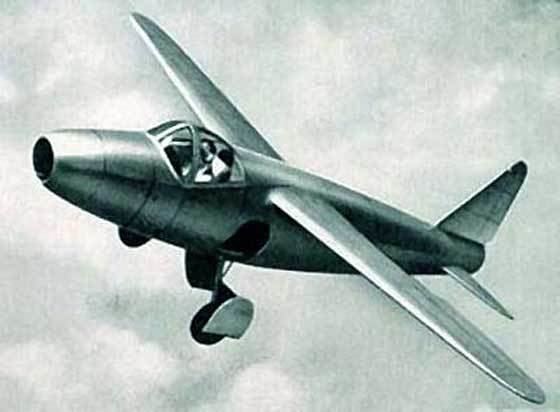
Heinkel he 178 rc jet aircraft by bruce grey
Development
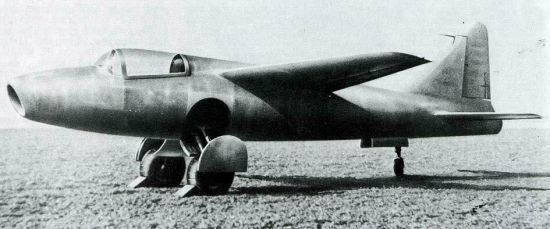
In 1936, a young engineer named Hans von Ohain had taken out a patent on using the exhaust from a gas turbine as a means of propulsion.
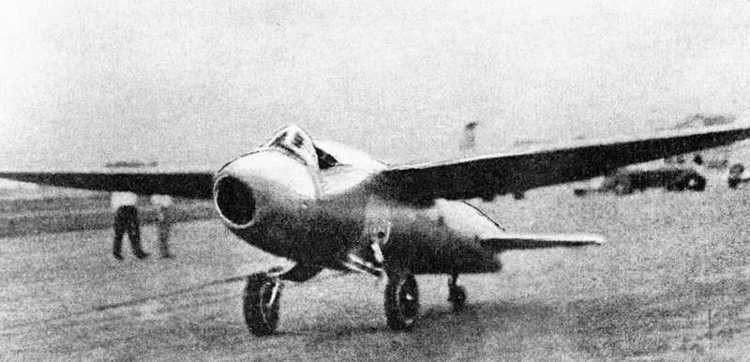
He presented his idea to Ernst Heinkel, who agreed to help develop the concept. Von Ohain successfully demonstrated his first engine, the Heinkel HeS 1 in 1937, and plans were quickly made to test a similar engine in an aircraft. The He 178 was designed around von Ohain's third engine design, the HeS 3, which burned diesel fuel. The result was a small aircraft with a metal fuselage of conventional configuration and construction. The jet intake was in the nose, and the aircraft was fitted with tailwheel undercarriage. The main landing gear was intended to be retractable, but remained fixed in "down" position throughout the flight trials.
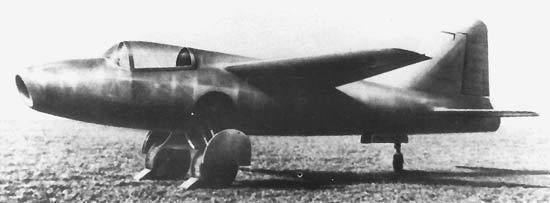
The high-mounted wooden wings had the characteristic Günter brothers elliptical trailing edge. Photos showing a "straight wing" (straight-line-taper in the wing planform, for both the leading and trailing edges) were of the second prototype He 178 V2, which never flew under power.
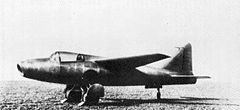
The aircraft made its maiden flight on 27 August 1939, only days before Germany started World War II by invading Poland. The test pilot was Erich Warsitz, who had also flown the world's first rocket powered airplane, the Heinkel He 176, on its maiden flight in June 1939.
Heinkel had developed the turbojet engine and the testbed aircraft, the Heinkel He 178 V1, in great secrecy. They were kept secret even from the German air force and On 1 November 1939, after the German victory in Poland, Heinkel arranged a demonstration of the jet for officials, which Herman Goering, commander in chief of the Luftwaffe, did not attend. Ernst Udet and Erhard Milch, Minister of Aircraft Production and Supply watched the aircraft perform, but were unimpressed. While a technical success, speeds were limited to 598 kilometres per hour (372 mph) even when fitted with more powerful HeS 6 1,300lb thrust engines and combat endurance was only 10 minutes.
Undeterred, Heinkel decided to embark on the development of a twin-engine jet fighter, the He 280 as a private venture using what had been learned from the He 178 prototype.
The sole He 178 V1 airframe was placed on display at the Berlin Aviation Museum, where it was destroyed in an air raid in 1943.
Significance
Ernst Heinkel was disappointed by the lack of official interest in his private-venture jet. In his autobiography, he attributes this to the failure of the leaders of the Reichsluftfahrtministerium to understand the advantages of jet propulsion and what breakthrough the He 178 represented. In fact, the Reich Air Ministry was already developing its own jets, a fact unknown to Heinkel.
In 1939, BMW and Junkers were working on "official" turbojet engines (bearing RLM-issued "109-0xx" design numbers, used for all gas-turbine propulsion aircraft powerplants) for the German military. These were axial-flow turbojets, which promised much less drag than the centrifugal-flow turbojets like those being developed at Heinkel and by Frank Whittle in England.
In mid September 1939, two weeks after Germany started World War II, the German air force ordered aircraft manufacturers to reduce development work and concentrate all efforts on winning what German officials expected to be a short war. But the development of jet powered single-seaters was ordered to continue, to get such aircraft operational as fighters as soon as possible.
This could have happened had not Willy Messerschmitt cautioned Hitler, in a conversation on 27 June 1943 at Obersalzbeg reported by Rakan Kokothaki, against mass-production of jets on the grounds of fuel consumption. This seems to have marked a turning point for jet aircraft, Hitler deciding that the most promising jet fighter aircraft be re-purposed as a 'blitz bomber'.
(Ziegler speculates that the prospect of a damaged but airworthy Me 262 falling into allied hands drove this decision: at the time it was not known that the allies were perhaps only a year behind the technical lead established by Nazi Germany and that the idea of a 'secret weapon' falling into enemy hands may have played upon Hitler's mind. Whatever the reason for this pronouncement the effect was to greatly delay the introduction of jets per se.)
The result of the decision to change the Me 262 from an already capable single-seat fighter/interceptor into - at best - a rather indifferent two-seat light bomber was such that operating the type as fighters was delayed by a year and when in squadron service in pitifully low numbers. (This decision seems even more perverse when conventional fighter-bombers were already available, jet-powered equivalents could have no major effect on the outcome of the war, and the conversion process actively prevented action against the allied heavy bomber 'round-the-clock' campaign that was slowly degrading Germany's war production.) In December 1943, having listened to many and varied objections regarding the 'Blitz Bomber', Goering issued an order to the effect that by Spring 1944 'the Luftwaffe [shall have] sufficient operational fighter-bombers'. Ironically in July 1944 both the German and British air forces began flying jet powered fighters operationally.
The British Gloster Meteor F.I, powered by two Rolls-Royce Welland centrifugal-flow turbojets had a maximum speed (in level flight) of 692 km/h (430 mph) and thus only equivalent to the best-performing piston engined Allied fighters being flown in combat at that time, whereas the German Messerschmitt Me 262, powered by two Junkers Jumo 004 axial-flow turbojets, had a maximum speed of 870 km/h (540 mph),—178 km/h (111 mph) faster than the best piston-engined fighters and had superior climb performance, but those bald statements do not reflect the operational issues surrounding each type: the German jet engines had a service life of about 25 hours (in part due to the shortage of suitable heat-resistant steel alloys) while the British centrifugal jet engines could run for 180 hours. While no jet-to-jet air combat took place in July 1944 the first encounter between a German Me 262 and a British Mosquito (of roughly similar performance to the Meteor) ended bloodlessly.
When used as an air-superiority fighter, the task for which it had been designed, the Luftwaffe's Me 262s performed admirably but this was at a time when Hitler's stricture that no one could so much as mention the aircraft unless it was in the context of its use as a bomber effectively concealed this inconvenient truth. In September 1944 this policy was reversed but by then it was too late, there were far too few Me 262 available to make a difference, and far too few pilots.
By contrast at this stage in the war the RAF used the Meteor to shoot down unmanned V-1 flying bombs, maintain coastal patrols and for training, where its ability to reach speeds in excess of 500 mph in a dive effectively simulated attacks by the ever-dwindling numbers of technically superior but effectively irreplaceable German jets.
Specifications
General characteristics
Performance
Armament
None
